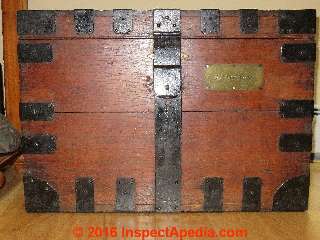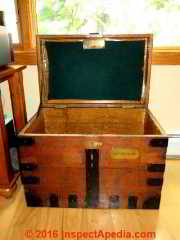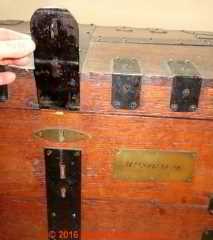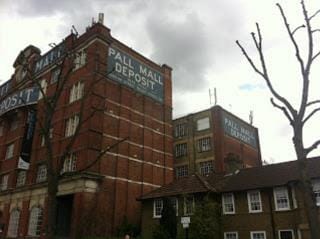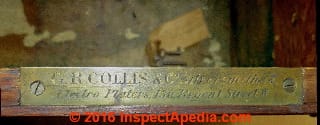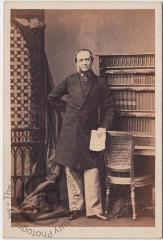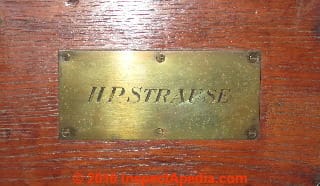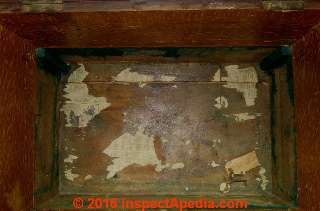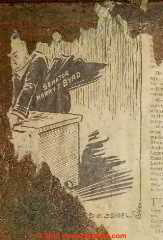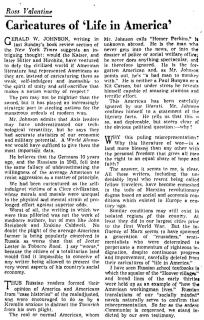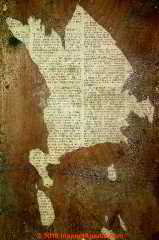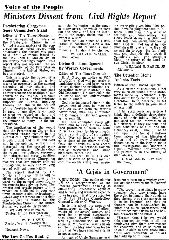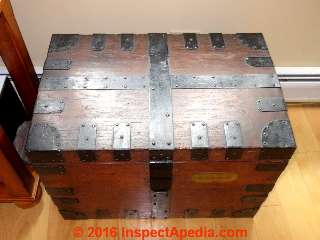 The Cornwallis Ricketts Strause Silver-Chest
The Cornwallis Ricketts Strause Silver-Chest
- POST a QUESTION or COMMENT about Sir Cornwallis Ricketts, Bar. R, H.P. Strause, & London silversmiths G.R. Collis & Co., in researching the history and provenance of an antique silver storage chest purchased in Richmond Virginia in 1949.
Antique silver storage chest belonging to Sir Cornwallis Ricketts & H.P. Strause
Tracing the Antique H.P. Strause / Sir Cornwallis Ricketts, Bar. R., Silver Chest. This article describes tracing the history of an antique chest and using the text of newsprint glued inside the chest to news reports on events faced by its owners between 1835 and 2016. This article gives information about Sir Cornwallis Ricketts, Bar. R, H.P. Strause, & London silversmiths G.R. Collis & Co.
InspectAPedia tolerates no conflicts of interest. We have no relationship with advertisers, products, or services discussed at this website.
- Daniel Friedman, Publisher/Editor/Author - See WHO ARE WE?
The Cornwallis Ricketts Silver Chest Story
[Click to enlarge any image]
Daniel Friedman, Poughkeepsie, New York 2016/05/13
Researching the history and provenance of an antique silver storage chest purchased in Richmond Virginia in 1949 took advantage of brass tags, construction details, and glued-in newspaper liner fragments to use names & text string searches to find the date and original articles.
The path of this antique chest wanders from a London silversmith to London's Pall Mall Furniture Storage Facility, through owners Baron Cornwallis Ricketts and then H.P. Strause to Richmond Virginia where the chest was purchased by Teal Friedman ca 1949.
News clippings in the chest liner give insight to political and social conditions in Richmond as the city faced desegregation in May 1949.
Recent History of the Cornwallis / Strause Chest - empty of contents it becomes a blanket box
This chest has been in my family since the 1950’s but has a much older history as is suggested by both scraps of newspaper that remain glued to its bottom and a search on the names and companies represented by brass plaques in the trunk lid and on the edge of its front wall. A history of the chest is interesting as names it carries find people whose own story can still be told.
Historical research dates the chest’s manufacture and the production of its original contents (silver items) to a period between 1835 and 1885. Ownership tags identify the original owner of the chest and its content, subsequent owners, and the manufacturing silversmiths.
As the original owner, Sir Cornwallis Ricketts, died in 1885 we can be confident that the chest, labeled with his name, and its contents were produced before that year.
Above: The Corwallis / Ricketts / Strause chest at its home in Poughkeepsie, New York, having traveled from England to Richmond, to Florida, to New York. Having been cleaned, documented, and now lined with thin foil-faced insulating foam sheets, the chest serves as a small wine storage container.
Newspaper clipping fragments glued to the chest bottom, remains of newsprint used as a liner, bring the chest to Virginia during the Civil Rights movement and include some interesting history of the position of the Presbyterian Church on civil rights at that time.
My mom, Teal Friedman, reported that this chest originally held “wedding silver”. When the chest was purchased by my mom it was, of course empty of the sliver that it originally contained. With an abiding interest in antiques and friends in the antique business herself, it’s likely that mom bought this chest from a Richmond VA. antiques dealer.
This “trunk” as we called it was at the foot of my bed at our home in Richmond when I was a small child in the 1940’s and 1950’s. It served as a storage box for blankets and sheets rather than silver items.
My red plastic tube-operated radio sat atop the trunk at the foot of my bed. I often would pull my blankets over the radio and trunk, creep down under the covers head-to-foot area, and turn on the radio at night to listen to Sky King and other radio shows when I was supposed to be asleep. The radio tubes would make a dim orange light that gave an eerie glow to the radio stories as they were told.
This was “old time radio” before it was “old time”. It was hell-hot under those covers thanks to the radio tubes. One wonders that I never set the blankets afire.
Mom died on Saturday, the 9th of July, 2015 in Boca Raton, Florida. She was 97. Ultimately the HP Strause chest was shipped to me from her estate, on my request.
Origins of The Cornwallis Silver Chest
The exterior of this oak chest is reinforced with iron banding and includes a double locking system commonly used for extra security in shipping valuables in chests in the 19th century and perhaps earlier.
Keys & Key Tags to the Cornwallis Chest
A paper tag attaches two keys found in the chest. The tag is labeled Pall Mall Deposit, Carlton Street, Lower Regent St. - a shopping area in London. It’s reasonable to infer that this is where the chest was sold to an individual or dealer who later brought the chest to the U.S.
The original keys for the two locks are tagged: “1st [key], Sliver Chest, all fitted wood trays, and other illegible script. The back of hit key tag contains numbers 1282 / 355 that may have been lot numbers in antiques inventory or possibly a price.
Regent Street is one of the major shopping streets in the West End of London, well known to tourists and locals alike and famous for its Christmas illuminations. It is named after the Prince Regent (later George IV) and is commonly associated with the architect John Nash, whose street layout survives, although all of his original buildings except All Souls Church have since been replaced.
The street was completed in 1825 and was an early example of town planning in England, cutting through the 17th and 18th century street pattern through which it passes.
It runs from the Regent's residence at Carlton House in St James's at the southern end, through Piccadilly Circus and Oxford Circus, to All Souls Church. - En.Wikipedia, 2016/05/13 - https://en.wikipedia.org/wiki/Regent_Street
The Pall Mall deposit was and remains a London facility [connected with the Portobello market.]
With an imposing period facade dating back to 1901, Pall Mall Deposit was originally a safe deposit for furniture. - Ret. 2016/05/13 - http://www.pallmalldeposit.co.uk/
Brass Tags on the Chest
The chest is marked with three brass tags, each of which tells something of the origin and prior owners of the chest and its contents.
1. H.P. Strause – on the chest front
2. G.R. Collis & Co., Silversmiths – on the upper edge of the chest front
3. Sir Cornwallis Ricketts, Bar. R. – on the inside of the chest lid – not its original location
G.R. Collis & Co., Silversmiths
G.R. Collis & Co., Silversmiths & Electro Platers, 130 Regent Street W. - appears on the chest front upper edge to the right of the edge lock plate, 11.6 x 1.5 cm, brass plate.
These are the silversmiths who produced the original contents of this chest and most likely that it was these silversmiths who had the chest manufactured to hold their work for the original customer who purchased the silver it contained.
George Richmond Collis & Co., were successors to Sir Edward Thomason, a London silversmith.
The history of G.R. Collis & Co. helps date this chest and its original contents as having been made between 1835 and 1888, the last year of operation of that firm. George Richmond Collis & Co. registered its silver hallmarks with the Birmingham Assay Office in several iterations between 1835 and 1846, suggesting that the chest and its original contents could have been produced as early as 1835.
The hallmarks and history of these silversmiths is discussed at several sources including www.silvercollection.it a web page displaying a private collection of silver items.
Sir Edward Thomason (c.1769-1849) was a dominant and memorable figure in Birmingham industry.
He was the son of a bucklemaker and apprenticed in Matthew Boulton factory. In 1793 he set up a shop in the button trade, diversifying and expanding the business into gold, silver and medals. In 1806 he entered a hallmark in Birmingham Assay Office as Thomason & Co. In 1810 Thomason extended his factory starting the production of close plated knives, forks and spoons.
In 1817 Thomason entered into an agreement with James Mudie to strike a series of medals recording British victories over Napoleon; the dies were engraved by English and French artists, and the results were published by Mudie in An Historical and Critical Account of a Grand Series of National Medals (1820). Thomason subsequently purchased the dies.
In 1819 he began a series of forty-eight medals of the Elgin marbles in the British Museum, which was completed by 1823. In 1828 his workmen finished a series of sixteen medals on scientific subjects, and two years later sixty medals on biblical subjects. Developing his usual practice of presenting medals to important figures, he sent examples of the biblical series to all European monarchs, as well as to the president of the United States and the emperor of China.
In 1832 he was knighted by King William IV, the first Birmingham manufacturer to be so honoured.
In 1835 Thomason retired and his manufactory in Church Street was acquired by George Richmond Collis (under the style George Richmond Collis & Co.)
Collis & Co continued to produce a wide range of goods, described in an 1839 advertisement as "Articles in the highest classes of the arts, in Gold, Silver, Plated Bronze & Or-Molu....". and in an 1849 advertisement "Manufacturers of Gold and Silver Services of Every Descriptions, Platers by the new process of Electro Plate on fine German Silver &c....".
The firm exhibited his production in Birmingham (1849) and London (1851 and 1862) Exhibitions, moving c. 1868 to Cambridge Street, Birmingham.
The firm had London branch at 130 Regent Street and Langham Place, Regent Street (c.1847). The premises in Regent Street were taken over in 1888 by John Bodman Carrington (Carrington & Co).In the same year (31st December 1888) Collis & Co disappeared as a separate concern and was absorbed by S.W. Smith & Co
Sir Cornwallis Ricketts
Sir Cornwallis Ricketts, Bar. R. appears on the chest lid underside at the front, 14 x 6.5 cm, brass plate.
This tag is secured by two poorly-driven brass screws to the underside of the chest lid behind the lock.
As you will see in the photo, the absence of screw holes beneath the other four holes in the brass plate and the fact that the plate is askew suggest that this is not the original location of this tag. Probably this tag was originally on the chest exterior and identified its original owner.
I suspect that a subsequent owner, Strause, removed but saved the Cornwallis Ricketts plaque by fastening it to the chest lid underside (above). Strause, or someone for Strause then secured the H.P. Strause plaque in the original Ricketts location on the chest face.
The Ricketts Baronetcy, of The Elms in the County of Gloucester and Beaumont Leys in the County of Leicester, is a title in the Baronetage of the United Kingdom. It was created on 15 February 1828 for Vice-Admiral Robert Ricketts.
Sir Cornwallis Ricketts, 2nd Baronet (1803–1885), was the eldest son of the 1st Baronet. - Retrieved 2016/05/13, original source: https://en.wikipedia.org/wiki/Ricketts_baronets
Born on 27 February 1803. Sir Cornwallis Ricketts succeeded as 2nd Baronet on 16 August 1842. He entered the Navy on 9 August 1816. He became a Lieutenant on 20 March 1823, a Commander on 10 August 1831, a Captain on 9 November 1846, retired as a Rear-Admiral on 15 June 1864 and eventually rose to the rank of Retired Admiral on 1 August 1877.
He married, firstly, Henrietta Tempest, daughter of Colonel John Plumbe, on 31 May 1834. He married, secondly, on 29 January 1852, Caroline Augusta Pelham-Clinton, fourth daughter of Henry Pelham-Clinton, 4th Duke of Newcastle-under-Lyme.
Above: Sir Ricketts in 1881.
Sir Ricketts and his wife appear on the 1881 census, living at 46, Grosvenor Place, London, with four unmarried daughters and at least six servants. He gave his place of birth as Pangton, in Devon, and his rank and profession as 'Baronet, Magistrate for Leicester, Admiral Retired'.
Sir Cornwallis Ricketts died on 28 January 1885 at the age of 81. - Retrieved 2016/05/13, original source: http://www.19thcenturyphotos.com/Sir-Cornwallis-Ricketts-R.N.
Lady Caroline Augusta Pelham-Clinton was the daughter of Henry Pelham Pelham-Clinton, 4th Duke of Newcastle-under-Lyme and Georgina Elizabeth Mundy.1 She married Admiral Sir Cornwallis Ricketts, 2nd Bt., son of Robert Tristram Ricketts and Rebecca Eliza Gumbleton, on 29 January 1852.1 She died on 3 June 1898. Her married name became Ricketts. - Retrieved 2016/05/13, original source: http://www.thepeerage.com/p4979.htm
This Ricketts couple had six children. It is possible that descendants of the U.K. Ricketts family emigrated to Virginia and could have brought this chest along, perhaps joining other Ricketts family branch memers who had been in the U.S. since the early 1700's.
Or the chest could have passed to a Strause family member in the U.K. who then brought it to the U.S.
H.P. Strause
H.P. Strause appears on the Chest front exterior right, 14 x 6.5 cm, brass plate and was most likely a subsequent owner of this chest.
This tag is secured on the front right face of the chest by six brass screws, neatly-driven. This may have been the original location of the Ricketts plate and may identify the second owner of the chest.
N. P. & H. P. Strause appear in The Jewish South, a Richmond Virginia publication, issue 182 [?] on Friday July 8, 1898. And on 2 April 1898 H.P. Strause appears in news articles as one of the owners and general manager of the Henderson Telephone Company in Henderson, N.C. as newspapers reported that the company was expanding its operations.
Newspaper Clippings as Trunk Liner Update its History
Newspaper was used to line the chest bottom after it came to Virginia. Most of the newsprint has been torn out but interesting fragments remain.
Historical research found that the newsprint includes editorials and news reports from the Richmond Times Dispatch, a Virginia Newspaper published on 5 May 1949. It’s entirely possible that these pages were glued into the chest by mom.
Fragments of the Richmond newspaper tell us not quite when the chest came to the Colonies, but they can indicate where the chest was probably located when the newspaper liner was installed. Richmond, Virginia.
All of the clippings seem to be from a single issue of the Richmond Times Dispatch, a Virginia newspaper, and examination of the text enabled me to establish the publication date of the newspaper issue that was later used as chest liner.
A fragment includes a political cartoon of Senator Harry F. Byrd (D. VA) penned by Fred O. Seibel from an editorial page. Harry F. Byrd (1886 - 1966) was a Virginia state senator (1915-1925), Virginia state governor (1926-1930), and a U.S. senator (1933-1965). Senator Byrd opposed the New Deal and big-government and stood in opposition to the civil rights movement of the 1960's, including resisting federally-mandated school desegregation.
In the early 1960's, some white parents who asserted that they strongly supported the integration of Virginia's white schools nevertheless found placements for their teen-aged children in private schools, ostensibly not in opposition to de-segregation but out of fear that Byrd would be sure that Virginia's schools would simply remain closed rather than integrate.
Fred O. Seibel was a political cartoonist for the Richmond Times Dispatch [and possibly other newspapers].
Below is the full cartoon from the microfiche archives of the Richmond Times Dispatch.
The same news fragment discusses events in 1949 that date this newspaper issue to the 3 May 1949 issue of the Richmond Times Dispatch.
He believes that the Germans 10 years ago, and the Russians in 1945, fell into the same fallacy of underestimating the willingness of the average American to resist aggression as a matter of principle.
We had been caricatured as the self-indulgent victims of a Circe civilization, whose morals and morale were unequal to the physical and mental strain of prolonged effort against superior odds. Worst of all, the writing in which we were thus pilloried was not the work of mediocre authors, but of men like John Steinbeck and Erskine Caldwell. No doubt the plight of the average American farmer is being popularly [compared to ?] Russia as worse … Kremlin … Marxian revolution … - fragment
Searching the Richmond Times Dispatch archives for the text fragment above found the full article, an editorial by Ross Valentine titled “Caricatures of ‘Life in America’ on page 12 of the 5 May 1949 issue of that newspaper.
[Click to enlarge any image]
Another newspaper fragment, also from p. 12 of this newspaper issue discusses an All Virginia Music Festival held May 13-15 in Charlottesville, Va.
In an adjoining column to the right of the Virginia music festival article, we find an interesting position regarding the Presbyterian Church on civil rights in 1949, offering insight into a sentiment of less than full support of civil rights at the time.
The implication of the rep[ort] that the Presbyterian Church has renounced “State Rights” in the interest of alleged “human rights” is both unjust and false and does not, in our opinion, represent the historical nor the present position of our church. Neither does the report, we believe, represent the historical and present position of the Presbyterian Church on matters that are purely political propaganda or only the rolling cry of political demagogues.
The full text of this article by two Presbyterian pastors appears below.
[Click to enlarge any image]
More and very different historical events are disclosed in another newsprint fragment of page 10 of the same issue of the Richmond Times Dispatch:
An Associated Press report describes deaths from tornadoes in Oklahoma that caused an estimated $2,050,000 in damage as well as additional tornadoes in Western Kansas, Northwestern Louisiana (Sunday), and damage to power lines in Central and Northeastern Mississippi. Another death [Mrs. Jesse True… ] is reported.
The Yangtze River Incident, April 1949
In an abutting column to the tornado story is one of the most interesting news fragments in this May 3 1949 issue: a report on the Yangtze River Incident informing readers that British warships in the Yangtze river had been shelled by Communist forces.
London, May 2. … Prime Minister Clement Atlee told the house of Commons … that the British warship … in the Yangtze River .. had air cover if their … thought it necessary. … He said the… craft, however, 2000 … He said it … 48 hours to … Yangtze…
Just below is the full text of both of these articles.
Historical research provides the following details of the 1949 Yangtze Incident:
Between the 20th and 21st of April 1949 four Royal Navy warships, namely H.M.S. Amethyst, Consort, London and Black Swan, got caught up in the conflict, of the ensuing Chinese Civil war in China’s Yangtze River.
According to news report at that time, here in the United Kingdom the question on the lips of the populace was, ‘how could such an incident occur at a time when this nation was at peace?’
With that being the situation then, Prime Minister, Clement Attlee, on the 26th April 1949 within the House of Commons, and The First Lord Of The Admiralty (Viscount Hall), within the House of Lords, both made a statement to all assembled within the House of Commons and the House of Lords, regarding the incident, which is now referred to as the ‘1949 Yangtze Incident’ and by clicking on the links being provided here below, this will provide access the statement made by Prime Minister, Attlee and Viscount Hall, and the question that were asked by those assembled within both Houses.
(1). http://hansard.milbanksystems.com/commons/1949/apr/26/attacks-on-hm-ships-china
(2). http://hansard.millbanksystems.com/lords/1949/apr/26/the-yangtse-incident
At the beginning of link numbered (2) it will be seen that the First Lord of the Admiralty (Viscount Hall) states: ‘My Lord’s, I ask leave of your Lordships to intervene to make a statement on the circumstances in which His Majesty’s Ships were fired upon in the Yangtse River. The statement is similar to one now being made by the Prime Minister in another place.’
Then in continuation (Viscount Hall) is seen to have stated to all assembled within the house of Lords, the following, that I am about to quote from Hansard * “ The House will wish to have a full account of the circumstances in which His Majesty’s Ships were fired upon in the Yangtse River, with grievous casualties and damage.” * Unquote. - retrieved 2016/05/13, original source: http://www.thehmsconsort.co.uk/New%20hms%20consort/new%20hms%20consort/yangtze_incident_19492012.htm
Clement Attlee - a micro-history - adds background to the Yangtse Incident reported above.
Clement Richard Attlee, 1st Earl Attlee, KG, OM, CH, PC, FRS[1] (3 January 1883 – 8 October 1967) was a British politician who was the Prime Minister of the United Kingdom from 1945 to 1951 and the Leader of the Labour Party from 1935 to 1955.
Attlee was the first person to hold the office of Deputy Prime Minister of the United Kingdom, serving under Winston Churchill in the wartime coalition government, before going on to lead the Labour Party to a landslide election victory in 1945 and a narrow victory in 1950.
He became the first Labour Prime Minister ever to serve a full five-year term, as well as the first to command a Labour majority in Parliament, and remains the longest-ever serving Leader of the Labour Party. - retrieved 2016/05/13, original source: https://en.wikipedia.org/wiki/Clement_Attlee
Mentioned in other newsprint fragments on the bottom of this chest are the Secretary of the Army [U.S.], an Electric Bond, President Truman, and MacArthur.
What else was happening on May 3 1949 when Teal or someone else glued pages of the Richmond Times Dispatch to the bottom of this chest? Following an image of page 1 of the Times DispatchOn this date are links to PDFs of full pages of this newspaper issue.
3 May 1949 Newspaper Glued into this Antique Silver Storage Chest
These PDF files give full text and thus historical content describing conditions on 3 May 1949 when (probably my mom) glued pages of this newspaper as liner into the antique Ricketts-Strause Chest.
- Richmond Times Dispatch 3 May 1949 Front Page
- Richmond Times Dispatch 3 May 1949 Editorial page (fragments of which were found glued into this chest)
- Richmond Times Dispatch 3 May 1949 page 10 (fragments of which were found glued into this chest)
- Richmond Times Dispatch 3 May 1949 page 2 (fragments of which were found glued into this chest)
- Richmond Times Dispatch 3 May 1949 page 4 (fragments of which were found glued into this chest)
Mothball Odors Persist in Antique Wooden Chest
 Today this chest resides in our home in Poughkeepsie NY where the chest has been cleaned, lined with insulating board, and is mostly-empty, serving only to store an occasional bottle of wine.
Today this chest resides in our home in Poughkeepsie NY where the chest has been cleaned, lined with insulating board, and is mostly-empty, serving only to store an occasional bottle of wine.
For some decades woolen blankets were stored in this chest to which mothballs were added to prevent moth damage.
The persistence of the camphor odor or mothball smell is testimony to the persistence with which odors of mothballs can penetrate and persist in wood, fabric, and other materials.
Readers concerned with mothball odors should
...
Reader Comments, Questions & Answers About The Article Above
Below you will find questions and answers previously posted on this page at its page bottom reader comment box.
Reader Q&A - also see RECOMMENDED ARTICLES & FAQs
On 2017-03-27 by Liz Strause - this chest belonged to Henry P Strause
I believe this chest belonged to Henry P Strause who would have been my Grandfather's Uncle.
He worked for a tobacco company and traveled the world collecting antiques. He had a collection that was exhibited in the 1930's in Richmond.
He was a collector of some note. His clock collection was auctioned after his death. If you have any other pieces that may have come from his collection I would love to see photos of them.
He did live and travel to London in the early 1900's up until pre World War 2.
So I know he had storage spaces and containers shipped back to the US. I'm still trying to figure out what really happened to his collection as he had no children, and neither did his brothers.
On 2017-03-27 by (mod) -
Liz
Thanks so much for the posted comment.
Indeed and probably not coincidentally, when I was a boy growing up in Richmond my family were friendly with a Strause family who included a boy my age - Philip whom I recall (somewhat).
Richmond had a large tobacco warehousing industry and in fact one could not drive thorugh the "tobacco" district of the city in the 1950s without being imbued with the intense smell of tobacco hanging and curing in large warehouses in the city. So a connection between Henry P. Strause and tobacco and Richmond is a long and an historic one.
Most of what I know about this chest is published in the article above. Regrettably my mom passed away about a year ago so there's no one in my immediate family to ask about Henry's collection.
I suspect that mom either obtained the chest directly from your Grandfather's uncle Henry P. (perhaps Philip) or from Mac Reese, a Richmond antiques dealer and friend who may have purchased and thus had items from Henry's collection for later re-sale.
Mac Reese's own antiques store burned to the ground when I was a teenager. I recall it vividly because as a boy interested in pocket knives (no surprise) I had a collection that Mac had agreed to put into a deep display frame as a favor.
My collection was among the (least important) losses of his fire. So - very speculatively - if Reese had remaining items from Henry's collection at the time of the fire (probably in the 1960's in Richmond) then they were perhaps lost at that time.
Trying to track down Mac Reese and Reese's antiques does find this obituary for one of his employees, confirming some of what is otherwise dim in distant memories.
- Burnette, Mr. Marion F. Jr., 87, of Mechanicsville, a World War II Army veteran, a retired furniture finisher for Reese's Antiques in Richmond, widower of JoAnn Walker Burnette. - Richmond Times Dispatch, Obituaries for 14 August 2011, http://www.richmond.com/entertainment/article_8b5935c5-de55-5bfc-aca3-b144f5d0dbf4.html
On 2017-05-01 by Liz
I am just now seeing your reply, while doing further "Strause" research. Uncle Henry died suddenly and unexpectedly of a heart attack in Washington DC.
He did have two brothers that survived him that probably would have inherited his estate after probate if it wasn't in order. He had many containers that had been shipped from London where he resided at one time or another in his life.
I found his passport applications that listed him as having traveled to or lived in China, Japan, India, Sweden, Venezuela among other places (New York). So, I can only imagine the treasures he had collected.
He never even was able to open all of the containers prior to his death.
I am so sorry to hear about your loss of your beloved pocket knife collection. It's somewhat of a family mystery as to what happened to the "treasures" of my Uncle.
It includes some vitriol between my Nana, and her sister in law who I believe were fighting over the spoils after Henrys two remaining brothers passed away.
They, the brothers lived in Burlington Iowa which was once a bustling town on the Mississippi River, but was a dead town when I visited it 3 or 4 years ago. I did find info about his brothers, but didn't find any treasures in any antique stores.
There were several Strause families in Richmond that I could locate records on.
Phillip was Henry's fathers name~ and there may be others I haven't found yet. (so this is way more than your need to know about someone else's family history). My condolences on losing your Mom.
On 2017-05-01 by Mod
Thanks for the details, Liz. The Strause family were a respected name in Richmond Virginia in the 1950s and 1960s (and perhaps later) having been residents there for some time, and serving as operators of a large department store.
Philip Strause, a descendent, was my contemporary in religious school and a member of the Beth Ahaba synagogue in Richmond.
...
Continue reading at AGE of a BUILDING, HOW to DETERMINE - home page, or see the following articles related to antique or old homes or building components,or select a topic from closely-related articles below, or select a topic from the closely-related articles below, or see the complete ARTICLE INDEX.
Or see these
Recommended Articles
- AGE of a BUILDING, HOW to DETERMINE
- ANTIQUE & OLD LOG CABINS
- ANTIQUE CHEST Ricketts - Strause HISTORY
- ANTIQUE CHEST WOOD & FABRIC
- ANTIQUE FLUSH TOILETS
- DECK BUILDING & CARPENTRY TOOLS - antique hand tools
- DOOR HARDWARE AGE
- FIREPLACE INSERTS INSTALL, INSPECT, REPAIR - antique coal grates & fireplaces
- FORENSIC INVESTIGATION of BUILDINGS
- GAS LIGHTING PIPES FIXTURES
- HISTORIC HOMES - inspection of
- LINOLEUM & SHEET FLOORING - antique floor coverings
- OLD ELECTRICAL WIRING TYPES - antique electrical wiring
- SOLAR WATER HEATER ANTIQUE
- SOLAR HOT WATER HEATER TEMPERATURE CONTROL
- STEAM BOILERS GENERATORS CONTROLS, PRATT - antique generators, steam boilers, controls, equipment
Suggested citation for this web page
ANTIQUE CHEST Ricketts - Strause HISTORY at InspectApedia.com - online encyclopedia of building & environmental inspection, testing, diagnosis, repair, & problem prevention advice.
Or see this
InspectApedia.com General Information
There are more than 20,000 topics found in this building & indoor environment encyclopedia. For more detailed help, use the SEARCH BOX found on any InspectApedia page to ask a question or search this website.
- InspectAPedia.com © - Website Home Page
- ABOUT InspectApedia.com ©
- ACCURACY & PRIVACY POLICIES
- ARTICLE CONTRIBUTORS & REVIEWERS - author & reviewer credentials
- ARTICLE PROPOSAL GUIDELINES
- CITATION FORMAT GUIDE
- CONTACT InspectApedia.com
- CONTENT USE POLICY
- DIRECTORY LISTING & LINK EXCHANGE INSTRUCTIONS
- EDITORIAL & PRIVACY POLICIES
- HISTORY OF INSPECTAPEDIA
- WEBSITE ACCURACY & RELIABILITY - un-biased, accurate, human-expert researched information provided with no conflicts of interest
- WEBSITE & AUTHOR CREDIBILITY
- WEBSITE COPYRIGHT VIOLATION POLICY - This website's content is © protected
- WEBSITE DESCRIPTION
- WEBSITE POLICIES - InspectApedia
Ask a Question or Search InspectApedia
Try the search box just below, or if you prefer, post a question or comment in the Comments box below and we will respond promptly.
Search the InspectApedia website
Note: appearance of your Comment below may be delayed: if your comment contains an image, photograph, web link, or text that looks to the software as if it might be a web link, your posting will appear after it has been approved by a moderator. Apologies for the delay.
Only one image can be added per comment but you can post as many comments, and therefore images, as you like.
You will not receive a notification when a response to your question has been posted.
Please bookmark this page to make it easy for you to check back for our response.
IF above you see "Comment Form is loading comments..." then COMMENT BOX - countable.ca / bawkbox.com IS NOT WORKING.
In any case you are welcome to send an email directly to us at InspectApedia.com at editor@inspectApedia.com
We'll reply to you directly. Please help us help you by noting, in your email, the URL of the InspectApedia page where you wanted to comment.
Citations & References
In addition to any citations in the article above, a full list is available on request.
- In addition to citations & references found in this article, see the research citations given at the end of the related articles found at our suggested
CONTINUE READING or RECOMMENDED ARTICLES.
- Carson, Dunlop & Associates Ltd., 120 Carlton Street Suite 407, Toronto ON M5A 4K2. Tel: (416) 964-9415 1-800-268-7070 Email: info@carsondunlop.com. Alan Carson is a past president of ASHI, the American Society of Home Inspectors.
Thanks to Alan Carson and Bob Dunlop, for permission for InspectAPedia to use text excerpts from The HOME REFERENCE BOOK - the Encyclopedia of Homes and to use illustrations from The ILLUSTRATED HOME .
Carson Dunlop Associates provides extensive home inspection education and report writing material. In gratitude we provide links to tsome Carson Dunlop Associates products and services.


